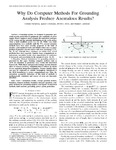Mostrar o rexistro simple do ítem
Why do computer methods for grounding analysis produce anomalous results?
| dc.contributor.author | Navarrina, Fermín | |
| dc.contributor.author | Colominas, Ignasi | |
| dc.contributor.author | Casteleiro, Manuel | |
| dc.date.accessioned | 2005-12-05T11:29:06Z | |
| dc.date.available | 2005-12-05T11:29:06Z | |
| dc.date.issued | 2003 | |
| dc.identifier.issn | 0885-8977 | |
| dc.identifier.uri | http://hdl.handle.net/2183/333 | |
| dc.description | Aceptado en "IEEE transactions on power delivery" | es_ES |
| dc.description.abstract | [Abstract] Grounding systems are designed to guarantee personal security, protection of equipments and continuity of power supply. Hence, engineers must compute the equivalent resistance of the system and the potential distribution on the earth surface when a fault condition occurs [1], [2], [3]. While very crude approximations were available until the 70’s, several computer methods have been more recently proposed on the basis of practice, semi-empirical works and intuitive ideas such as superposition of punctual current sources and error averaging [1], [3], [4], [5], [6]. Although these techniques are widely used, several problems have been reported. Namely: large computational requirements, unrealistic results when segmentation of conductors is increased, and uncertainty in the margin of error [2], [5]. A Boundary Element formulation for grounding analysis is presented in this paper. Existing computer methods such as APM are identified as particular cases within this theoretical framework. While linear and quadratic leakage current elements allow to increase accuracy, computing time is reduced by means of new analytical integration techniques. Former intuitive ideas can now be explained as suitable assumptions introduced in the BEM formulation to reduce computational cost. Thus, the anomalous asymptotic behaviour of this kind of methods is mathematically explained, and sources of error are rigorously identified. | es_ES |
| dc.format.mimetype | application/pdf | |
| dc.format.mimetype | text/plain | |
| dc.language.iso | eng | es_ES |
| dc.publisher | IEEE Power Engineering Society | es_ES |
| dc.relation.uri | http://www.ieee.org/organizations/pubs/transactions/tpd.htm | es_ES |
| dc.rights | © 2003 IEEE. Personal use of this material is permitted. However, permission to reprint/republish this material for advertising or promotional purposes or for creating new collective works for resale or redistribution to servers or lists, or to reuse any copyrighted component of this work in other works must be obtained from the IEEE | es_ES |
| dc.subject | Anomalous results | es_ES |
| dc.subject | Average potential method | es_ES |
| dc.subject | Boundary element method | es_ES |
| dc.subject | Boundary integral equations | es_ES |
| dc.subject | Computer methods for grounding analysis | es_ES |
| dc.subject | Convergence of numerical methods | es_ES |
| dc.subject | Fault currents | es_ES |
| dc.subject | Grounding | es_ES |
| dc.subject | Power system protection | es_ES |
| dc.title | Why do computer methods for grounding analysis produce anomalous results? | es_ES |
| dc.type | info:eu-repo/semantics/article | es_ES |
| dc.rights.access | info:eu-repo/semantics/openAccess | es_ES |
Ficheiros no ítem
Este ítem aparece na(s) seguinte(s) colección(s)
-
GI-GMNE - Artigos [54]






